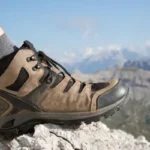If you’re an avid hiker, you know that proper footgear is essential for any outdoor adventure. Hiking boots are designed to protect your feet from the elements and provide extra traction and stability on uneven terrain. But How Should Hiking Boots Fit? Let’s explore what makes a great pair of hiking boots to get the perfect fit for your outdoor excursions.
How Should Hiking Boots Fit | Let’s Find Out
Finding the Right Size
The first step when looking for a new pair of hiking boots is to ensure you have the correct size. This means being aware of both length and width. When it comes to length, there should be enough room in the toe box area for your toes to move comfortably without rubbing against the front or sides of the boot.
Regarding width, your feet must be snugly held inside the boot with no excess space left around them. This will help prevent blisters caused by too much movement inside the boot while walking. It’s also important to note that different brands may use different sizing conventions, so try on multiple pairs from different brands before making a final decision.
Breaking In Your Boots
Once you’ve found a pair of hiking boots that fit correctly, it’s time to break them in for optimal comfort and performance during hikes. This process typically takes about eight hours of wear time over several days or weeks, depending on how often you plan to wear them.
During this time, ensure that your feet don’t become too sore and take regular breaks if needed until they feel comfortable in their new shoes. Additionally, some hikers prefer to treat their boots with a waterproofing spray before entering wet or muddy conditions, as this can help protect them from water damage over time.
Choosing Quality Materials
Finally, when selecting a pair of hiking boots, it’s essential to consider the materials used in their construction. Look for high-quality leather or synthetic materials such as nylon or polyester, which will provide superior durability while remaining lightweight and breathable on longer hikes. Also, keep an eye out for features such as waterproof membranes, which will protect against water damage and increase comfort levels even further.
Also Read: How Should Hiking Shoes Fit?
Is It Better For Hiking Boots To Be Bigger or Smaller?

Shopping for the perfect pair of hiking boots can be challenging, and it’s common to find yourself debating between a pair that is slightly too big or too small. Regarding which size will provide the most comfort and convenience on the trail, experts often recommend choosing a pair of hiking boots slightly larger than your regular shoe size.
That extra wiggle room should offer enough space at the front (toe box) to protect your toes from banging against the ends while walking long distances while still allowing the boot to securely grip your heel and fit snugly around your ankle for optimal support.
Plus, wearing thicker-socked liners means more cushioning, support, and warmth – all reasons why bigger might be better for tackling any terrain you may come across on your hike.
Also Read: Are Hiking Shoes Good For Walking?
How Much Room Should Be At The End Of Hiking Boots?
When selecting the right pair of hiking boots, it’s just as important to consider your foot size and shape as it is to know exactly how much room should be at the end. The best way to ensure your feet are comfortable and stable on those long treks across rugged terrain is to ensure you have a half-inch of space between your longest toe and the front of the boot.
Too small, and you’ll have aching toes; too large, and you’re in danger of blisters from moving around inside the boot. Finding a good balance between snugness around your heel and plenty of girth in the midsection without scrambling into the rest of your foot is also essential.
All this considered, don’t overlook that extra half inch when trying new boots — it can make all the difference for a successful outdoor adventure!
Also Read: How Long Do Hiking Shoes Last?
Conclusion:
Now you know, How Should Hiking Boots Fit? When shopping for a new pair of hiking boots, it’s essential to consider size, breaking-in period, and materials when making your purchase decision to get the best fit possible for all your outdoor adventures!
With these tips in mind, finding a great pair of shoes is easy—and once you do find them, they’ll last many years with proper care and maintenance! With great-fitting shoes come options – choose wisely! Happy trails!



